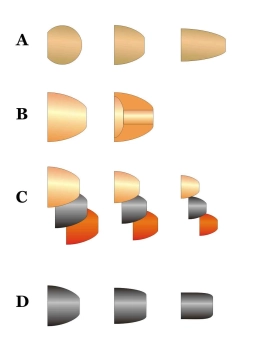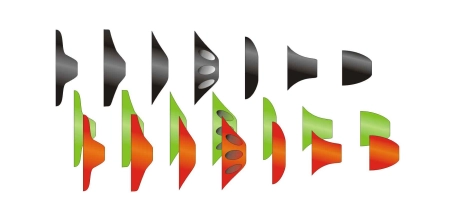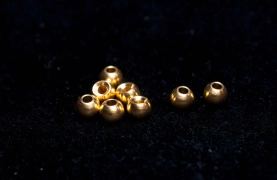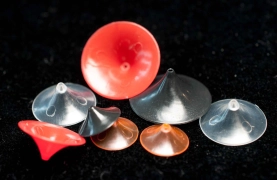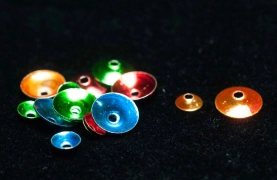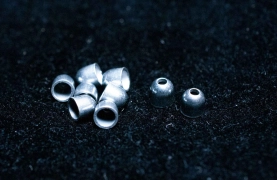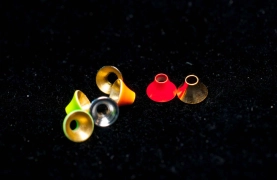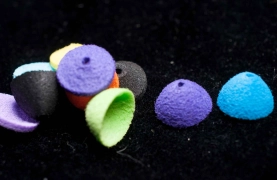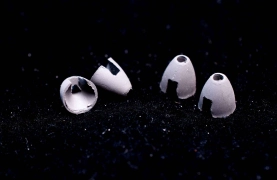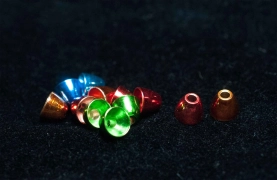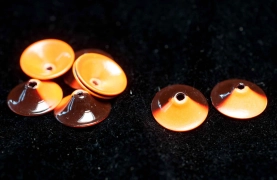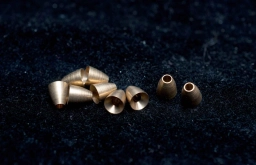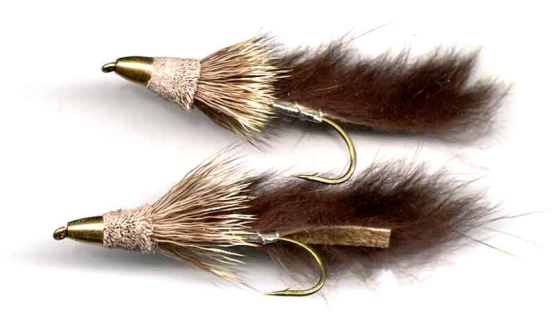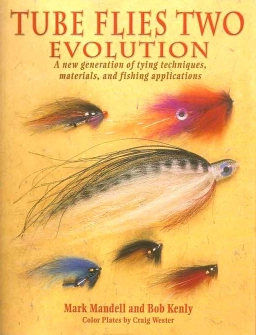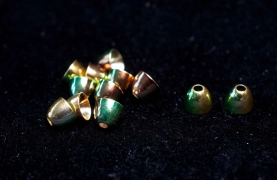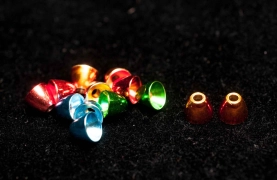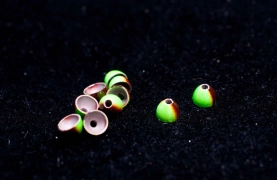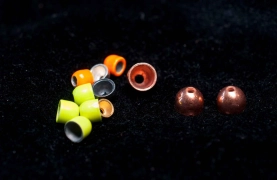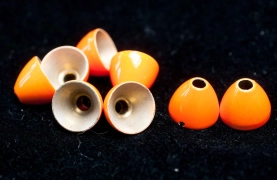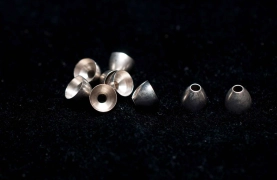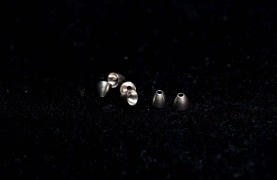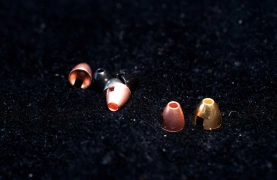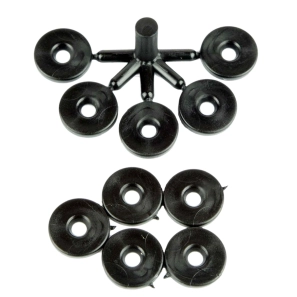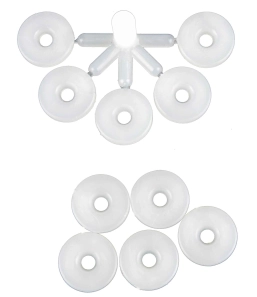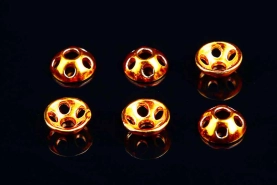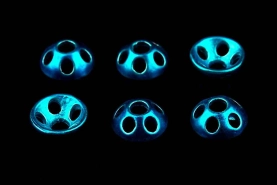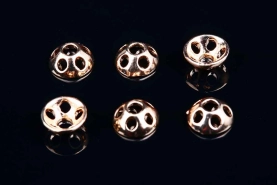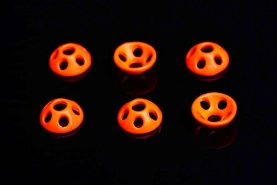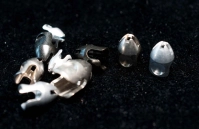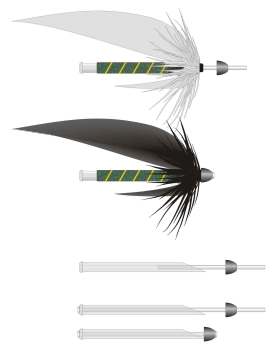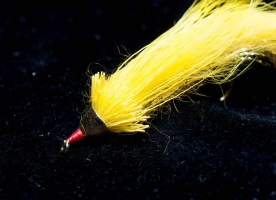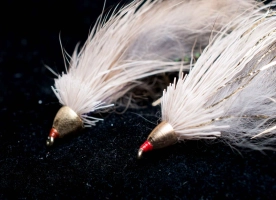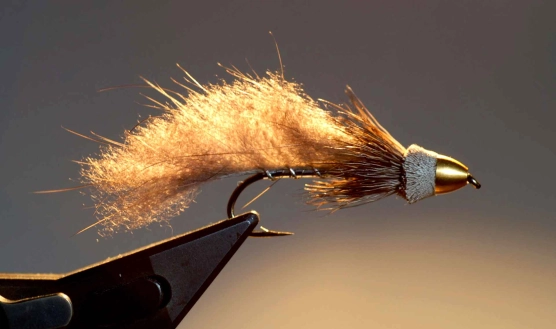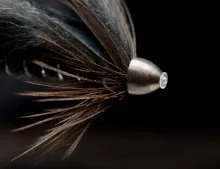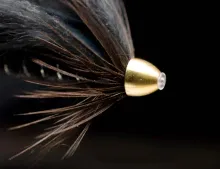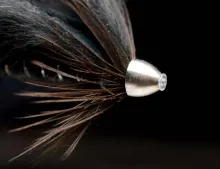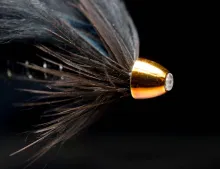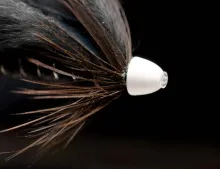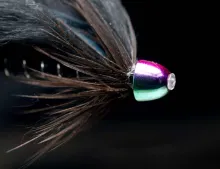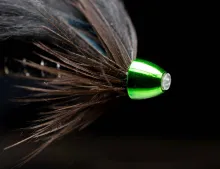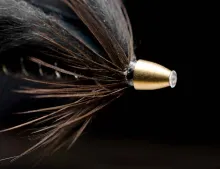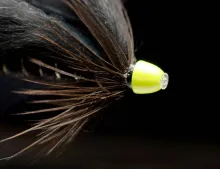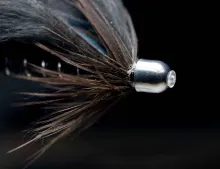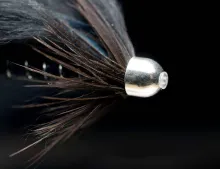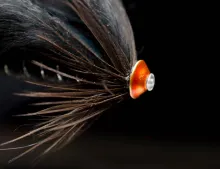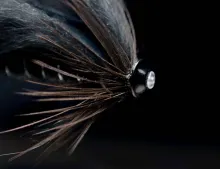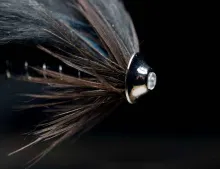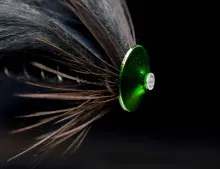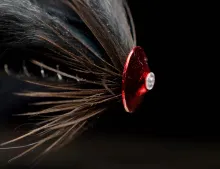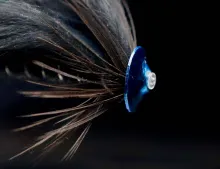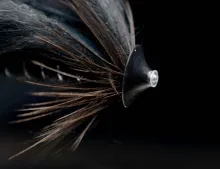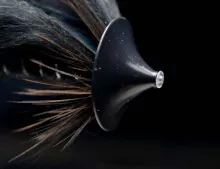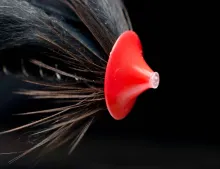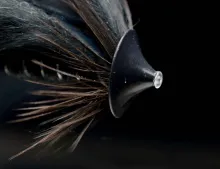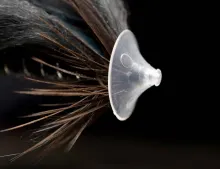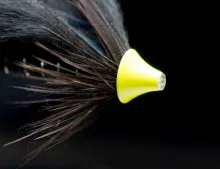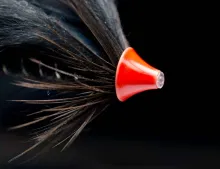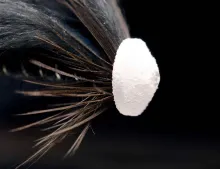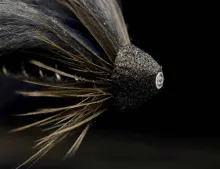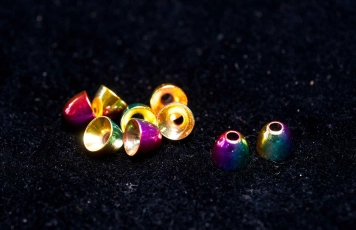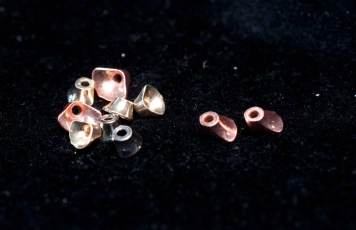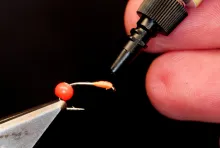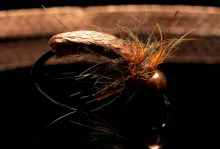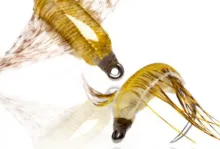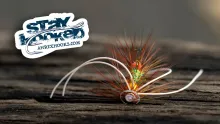A lot of flies - salmon tube flies in particular – use different discs or cones, and the market is full of them. Here's an overview of some of the many types.
Coneheads and discs are the rage on salmon flies. Basically all tube flies tied for salmon fishing feature some kind of cone or disc these days. On hooks it's much more uncommon to see cones or discs – for reasons which may become obvious later.
Bead, cone, disc
I'm going to use three terms in this article:
Beads: These are the classic ball shaped heads used for nymphs and certain other flies since a long time back. The history of the beaded fly most likely reaches back more than 100 years, and has its outset in using pearls, which were later on replaced by brass beads made for the purpose and later again popularized by Austrian Roman Moser during the 70's and 80's. Today beads are available in a colossal number of materials and colors, even shapes with faceted and flattened variations from many brands.
Cones: Cones are beads shaped as rounded cones or bullets. The material is metal, normally brass, aluminum or tungsten, but sometimes also plastic. Again we see a bunch of different colors, some anodized, some painted and others simply polished. Some cones have depressions for eyes, but the far majority is just a plain bullet shape, even though this can vary – some being narrow and long, some being wide and plumb.
Discs: Discs are short, flattened cones, basically looking like small conical Chinese straw hats. Discs are available in an even larger number of shapes and materials, some are rounded - convex or concave, some are flat, some are plain cones, some have holes.
The history of cones and discs is covered below.
Materials
Cones and discs can be made in many different materials. Common materials are tungsten, brass, aluminum, plastic, rubber and even foam.
Brass is the most common material, giving a suitable combination of weight and durability – plus the benefit of being easy to work with. A far majority of cones and discs are made from brass.
Aluminum is the second most common material, and if you want shape and color, but not too much weight, this is the material you want. A lot of anodized cones and discs are made from aluminum, which is even easier to work with than brass.
For sheer weight, tungsten is much heavier than brass, but also more expensive and harder to work with. Still tungsten cones are fairly common, while discs are rarely seen in tungsten.
A single cone manufacturer makes cones in a kind of tungsten/rubber material, which is soft but still very heavy. This isn't a common material, but useful for some applications.
More and more discs and cones are made from hard plastic. This material can be molded into almost any shape and the color selection is endless. More complex shapes such as the drainer or turbo discs with holes are mostly made in plastic, and a whole bunch of different shapes and colors are available. Most plastic parts are pretty durable, but will not last as long as metal. And plastic doesn't add any weight worth mentioning.
You will also see discs made from soft, rubbery plastic. These allow for some shaping and are more durable than the hard plastic ones. They are typically available in a large selection of colors, and oftentimes in milky or translucent versions too.
Foam is a material sometimes seen used in cones. Foam is soft and pliable and even adds buoyancy to the fly because it contains air.
Color
Cones and discs are usually available in a colossal number of colors, typically obtained using one of three different methods:
Plain material color: brass and different metals have a basic color, which can be left as is and give different metallic hues to the cones. They can be matte or polished, leaving the final impression more or less shiny. This color will of course last the lifetime of the cone, but it can go dull because of wear and oxidation. Plastic can be made in basically any color as well as translucent, and is often used. The color in plastic can fade and be worn dull, but will last very long.
Anodized: This is the most common way of coloring the material. Anodization is a chemical process that adds a thin layer of color in the metal. Anodization is very strong and almost impossible to wear off. Sometimes also called electroplated.
Painted: Different types of paint and varnish can be applied to metal cones. This can give a very bright color and even fluorescent colors, but is also the least durable method where the paint will often chip off or be worn – even before the fly gets in the water.
The history
I have been trying to dig into the history of the cone head, but that wasn't really fruitful at first. The development of cones very likely comes from beads, where the history is fairly well known and has been told on this site by Austrian Roman Moser, probably the tyer responsible for the second coming of the beads in the 70's and 80's.
Beads turned into cones made for hooks sometime in the 70's or 80's, and these cones were picked up by the Swedish anglers and tyers Mikael Frödin and Håkan Norling. They were initially added to tube flies in order to balance out the hook and make the fly swim properly, but Frödin noticed that flies with cones had a different movement in the water compared to flies with a small head made from thread. Soon he and Norling started experimenting with different cone shapes and sizes in combination with the softer materials like Arctic fox, which they had already introduced in flies such as the Temple Dog. The system was developed and expanded, and together with a manufacturer Frödin and Norling developed various shapes of cones including the wider ones known as turbo discs. Frödin published an article about the use of cones in the UK magazine Trout&Salmon some time in the early 90's, and this is probably the first mention of the concept of cones on tube flies and the first real source for this type of fly. I haven't been able to get my hands on this article, I even contacted Trout&Salmon, and did get reply, but haven't seen any article from them yet. So should anybody have a this magazine laying around, I'd be very happy to see a scan or a copy.
Frödin also originated the technique where a thinner inner tube is combined with the more traditional thicker outer tube - to create what I call a compound tube - to allow for a more elegant fly and an easier mounting of the cone.
I personally got my hands on some cones made for hooks by Roman Moser back in 1995 and tied my FMJNM (on a hook) the same year. I met Roman and his son Gregory at a fly tying show the next year and added a couple of articles on the subject of cones and beads to this web site. Moser had already tied and sold some cone headed streamers for some years at that point. We published several hook fly patterns with cones in the early and mid 90's, such as Bas Verschoor's Coney Flies, and later my own Full Metal Jacket Nutria Muddler and the Bullet Head Magnus.
We also covered the concept of cone heads used on tube flies in 1999 in this article, in which the Norwegian author even refers to Swedish Michael Frödin as his source for the idea - even though the author didn't have the method quite right. We have since then covered tube fly patterns, tying methods and materials - including cones and discs - in many other articles on the subject.
The tube fly as a concept has its roots back into the 1930's, but was not common for several decades. Bates mentions them briefly in his The Art of the Atlantic Salmon Fly from 1987, and in most of my salmon fly books listing contemporary flies, tubes are commonly covered. But we need to go into the 90's and even later than 2000 to really get cones into the picture. And no one refers in detail to the origin of the cones. As I worked my way through my library I realized that surprisingly few mentioned cones at all up until the late 2000's and well into 2010-2015.
Neither Hellekson's book Fish Flies nor Leeson & Schollmeyer's Benchside Reference mention coneheads. Leeson & Schollmeyer do have a small section on beads, but certainly no cones, and definitely no discs. These books are from the mid 90's and are all quite focused on US patterns, and since the cone style is European like the bead (or more precisely: Scandinavian/Swedish) , that might be an explanation. None of these books even mention tube flies, so there alone is also a reason for the lack of coverage of the cone head, which was even more common on tubes than on hooks already back in the early 90's.
Another book from 1995 – Mandell & Johnson's Tube Flies has plenty tubes (duh!), but still no cones. Their 2007 follow-up "Tube Flies Two" on the other hand has plenty cones (even on the front page), not least on the flies tied by Scandinavians, but also on many of the flies from other tiers, so in that 10-year period – mid 90's to mid 10's the cones made their real entry to the international fly-tying scene. The book features Håkan Norling who accounts for part of the story about the soft winged tubes and cones, but oddly enough Mikael Frödin is not one of the tyers, in spite of being mentioned as an originator by Norling and an inspiration by other featured tyers.
What the cone can do
Cones used on flies have several effects where some have more significance than others. Most tyers add the cones to serve one of these purposes:
Add weight and balance: Weight is probably the single most important feature of most cones. The brass and of course the tungsten ones add significant weight to plastic tube flies in particular, and can give the fly a diving motion and help it get down in hard current, but the primary purpose for the front weight is to help balancing out the weight of the hook and enable flies to swim without hanging low in the rear. Lighter cones made from aluminum or plastic add basically no weight while foam cones might even add buoyancy.
Add color: Many cones are brightly colored, and add a very visible spot of often contrasting color to the fly. Polished cones also add shine, while darker dull cones essentially add the same effect as a large varnished head as it's known from many full dressed salmon flies.
Add shape: The cone is a nice way of finishing a fly in the front, where tube flies in particular sometimes suffer from bad finishes in the form of large or small and sometimes clumsy heads. A series of flies finished with each their identical cone will gain greatly in consistency and style.
Hold materials: This goes along the same lines as above, because the hollow backside of a cone head will contain and cover the last materials tied in. It can be difficult to finish off tube flies on large diameter tubes in a discrete way, and by slipping a cone over the butts of wings and hackles, the tyer can completely hide the potential mess.
Create turbulence: The larger cones and the discs in particular will press the water around the fly in such a way than it helps the materials work and pulse. Soft materials such as marabou, ostrich and soft hair like Arctic fox will have a tendency to collapse and become a thin, one dimensional strip in a constant current. A disc will create turbulence in the front of the fly and help lift the materials and give the fly shape. People experiment with different shapes and holes to add to this effect.
Induce movement: If you reverse a funnel shaped disc, the cup made in the front of the fly will induce movement in the fly, much like it's known from hollow front poppers or wobblers with spoons. The hollow front will create instability and can make the fly wobble quite a bit. This isn't seen used than often, but cones are made by several manufacturers for this particular purpose. Most lightweight plastic cones can be used in the same way by simply reversing them.
Classic cones
The classic cone comes in an amazing variety of shapes, all having a basic bullet shape, but with varying proportions from very ling and slim to short and plumb. The hole drilled in the cone combined with its length limits the hooks it can be used on, simply because some cones can't pass the hook bend. A few cones are made with added slots to ease this passage.
When using cones on tubes, you will often use a thin inner tube to hold the cone, and you will need to aim for as tight as possible a fit for the best result. When using cones to finish off tube flies, you also usually want cones that have a fairly large hole in the backside in order to be able to cover up materials and thread.
The cone shape can vary from something that's almost a half sphere to something that's basically a cylinder with rounded edges. This shape influences the appearance of the fly more than its behavior as long as its diameter is kept small.
Conical discs
Discs come in an even larger number of variations, but have the common trait that they are wider than they are long. Some are just flat cylinders, some a conical (Chinese hat style), some have convex or concave fronts and some have more complex shapes.
All are essentially used to finish tube flies and add a wide front that can move water and create turbulence. The most common materials are aluminum and plastic, but heavier discs are finding their way to the market, enabling the to add significant weight and balance to the flies.
Flat discs
A few plastic discs are simple, flat cylinders, which pass over the tube and closes off the fly adding a flat front with a diameter slightly larger than the tube it's tied on.
Drainer/turbo/sonic discs
Some of the discs have holes in them, molded into the plastic or drilled in the metal. These holes create even more water movement around the front of the fly, and induce even further mobility in the materials. They are marketed under names such as Drainer and Sonic discs.
Foam cones and discs
Foam is used to create very large fronts on the flies, almost as a muddler head or even a popper head. The purpose is to create a massive front without the weight of the material. Since the foam is often air filled, the material even adds flotation to the fly, sometimes desirable when fishing a sinking line or leader where you want the fly to go higher in the water than the belly of the line.
Cones with eyes
A few cones have recesses for stick on eyes and even fewer come with eyes added from the manufacturer. These cones with eyes makes it easy to create very mobile and lifelike fish imitations, where the head adds weight to induce a jigging motion in the fly and the eyes add... well, eyes.
Cone and disc placement
You might think that the only obvious place to put the cone or the disc is in the front of a fly, but that's not the case!
Innovative fly tyers have been experimenting with various placements including to the rear as well as in the middle of the fly.
While the front mounted cone or disc adds weight and or turbulence in the front of the fly, a centrally mounted disc can help lift materials and create disturbances all along the fly, and cones and beads added in the middle of a fly can add weight that will no make the fly jig and can be hidden by materials.
Many modern flies feature several cones, discs and/or beads to obtain different effects, and you should not let yourself be limited to a simple front mounted disc or cone.
On hooks
Using these materials on hooks rather than tubes does lead to some issues. Since the cone or disc mostly sits in the front of the fly, it has to be added to the hook as the very first material, sliding it over the hook point and securing it in the front of the fly before adding other materials. This can offer problems with many cones, which simply can't pass the hook bend. Some cones have a large rear opening or a slot to facilitate this passing while others use a radically different approach: they are constructed to be mounted as the last material, passed over the hook eye and turned to lock them into position. This method is used in many of the fish head style cones, which feature eyes or have recesses for eyes.
No matter whether you mount tie cone or head before or after tying the fly, you will probably have to secure it using some kind of glue or LCR, and you will most likely also have to tie your fly with consideration for the cone, either pushing material into a front mounted cone from behind before or after having finished the the fly, or you will have to leave ample space for the head to fit over the front materials such as a wing or hackle.
Several patterns on this site demonstrate that this is easily possible as long as you plan a bit ahead.
Oh, the variation!
Below you see the same fly - a pretty neutral, black fur winged tube fly - mounted with 30 different cones and discs. And this is just a selection of what I have in my material boxes! The number of different shapes colors and materials is staggering, and - as it can be seen - changing the cone can significantly change the appearance of a fly.
In general you should select a cone or disc that serves a purpose: adding weight or buoyancy, adding color, adding shape, providing a large front or what other idea you may have. These things combine, of course: bright and heavy for a deep fishing fly that needs visibility, light, black and large for a night fly that must move some water.
You should also select a disc or cone that suits the size and proportions of your fly and covers the head wraps and materials sufficiently. In the gallery below you will see a few that don't do this (on purpose), and it's not becoming for the fly. When fishing it has no significance, but when looking at the fly, a little style isn't a bad thing.
Cones
|
|
|
|
|
|
|
|
|
|
|
|
|
|
|
Small discs
Medium and large discs
|
|
|
|
|
|
|
|
|
|
|
|
|
|
|
Foam
Sources
Cones and discs in various versions are becoming more and more common in fly shops, but below you will find a list of the prime manufacturers and sources for these materials.
 Bidoz Products
Bidoz Products
French Bidoz has cones in brass and tungsten in several sizes an colors. Bidoz also has a large selection of cone shaped heads with eyes or recesses for eyes. Bidoz also has an almost unparalleled selection of classic beads. Find retailers for your country or buy online on the Bidoz web site.
 Canadian Tube Fly Company
Canadian Tube Fly Company
Stuart Anderson's company in Canada has a whole range of tube materials including several types of cones and discs. The color range is wide and both light and heavy cones and discs are available. Traditional cones come in two sizes and many colors and finishes. There's a version with a smaller hole for thin inner tubes, and a version with a larger hole for the larger diameter tubes. A new and more cylindrical version called Flex Tube Cone has recently been added, also available in assorted colors. Discs are available in light and heavy versions. The heavier discs are called Monster Cones and come in four metallic finishes in three sizes, and the lighter version called Ultralight Monster Cones comes in a wealth of colors – solid as well as metallic – and several sizes.
 Eumer
Eumer
Eumer is a Finish company with a good selection of cone heads in their program. Several sizes and many colors are available. The reseller search function is a little odd, but with a little luck you should be able to find a local retailer or distributor.
 Falkenberg Fly Tools
Falkenberg Fly Tools
Danish supplier Peter Falkenberg sells his softcones foam cones. He has a large selection of colors, shapes and sizes, but unfortunately the web site is in Danish only, and online ordering is not easy. Try dropping him a comment if you are interested in his products.
 Frödin Flies
Frödin Flies
Swedish Mikael Frödin has an online shop where he sells both flies and materials. Click on the Webshop link in the left hand column. That will reveal a menu of products including FITS tubing and cones. You can buy the whole range of FITS tubing and cones, and the selection has just been expanded with new tungsten cones and half cones and is nothing less than overwhelming.
Unlike most of the other sources mentioned here, you can also buy finished flies, and basically all the tube flies are finished with cones or discs.
 FutureFly
FutureFly
Danish FutureFly has a huge selection of materials for tube flies, including various cones and discs. Most are metal, but FutureFly recently introduced the flat and simple plastic MV-Disc, which has become quite popular. FutureFly also carries a vast array of other tube fly materials including the tubes themselves and a large selection of furs and skins.
 Guideline (F.I.T.S)
Guideline (F.I.T.S)
Swedish/Norwegian company Guideline has a large selection of tube fly materials called the F.I.T.S system. This also contains all kinds of cones and discs in a wealth of sizes and colors. The F.I.T.S system also contains half cones. The web site is very confusing with no direct access to the tube materials, but search for F.I.T.S (no, there's no finishing point) and things will pop up. Guideline has a list of dealers you can search.
 Heritage Angling Products
Heritage Angling Products
This US wholesaler has a nice selection of cones and discs in many sizes and colors, and have a row of US retailers who should be able to easily service US customers.
The site http://www.heritageanglingproducts.com/ does not exist anymore.
 Pro Sportfisher
Pro Sportfisher
Danish Pro Sportfisher is best known for their modular tube system called Pro Nanotube/Microtube/Flexitube, which includes a number of different components including so called body weights and cones and discs. Pro Sportfisher has a large selection of plastic cones and discs called Cone Discs, Sonic Discs, Soft Discs and various combinations thereof. There are colors, sizes and shapes galore and all is made to combine easily. Pro Sportfisher also has other fly tying materials. You will find a worldwide dealer list on their web site.
 Tubeworx
Tubeworx
UK manufacturer Tubeworx has a broad selection of cones and discs (called Flow Cones) – as well as tubes and other parts for tube flies. Tubeworkz has both brass and tungsten cones and produce several painted colors as well as metallic finishes. You can find a dealer's list online.
The site http://www.tubeworx.co.uk has been taken over by a different business.
 Würm Tungstenshop
Würm Tungstenshop
German Würm Tungstenshop has a large selection of slotted (for hooks) and unslotted cones (for tube flies). Sizes go from minuscule (2.5 millimeters) to monster and can be delivered in many shapes, colors and finishes. Wurm also has other tungsten products such as beads, soft rubbery cones and much more. The web site is in German, but a machine translation is available and online shopping is possible.
- Log in to post comments

